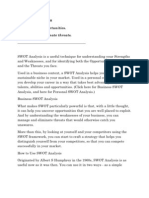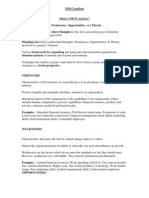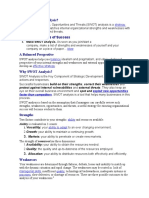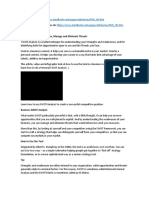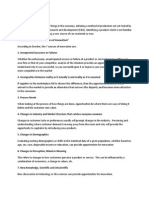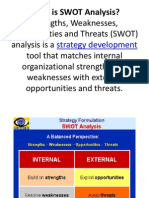Professional Documents
Culture Documents
#C # C&' (C '") ('CC'C &+ (,,'C&'"C ,-.$. $ / # 0 "C $ $ $$1 $ #
#C # C&' (C '") ('CC'C &+ (,,'C&'"C ,-.$. $ / # 0 "C $ $ $$1 $ #
Uploaded by
vaskar07Original Description:
Original Title
Copyright
Available Formats
Share this document
Did you find this document useful?
Is this content inappropriate?
Report this DocumentCopyright:
Available Formats
#C # C&' (C '") ('CC'C &+ (,,'C&'"C ,-.$. $ / # 0 "C $ $ $$1 $ #
#C # C&' (C '") ('CC'C &+ (,,'C&'"C ,-.$. $ / # 0 "C $ $ $$1 $ #
Uploaded by
vaskar07Copyright:
Available Formats
SWOT: The high-level self exam that boosts your bottom line.
How to bring maximum benefit to your twice-yearly marketing update.
By Lonnie Hirsch and Stewart Gandolf, MBA
Strategic planning demands realistic and objective assessment. At least twice each year, use the SWOT analysis to discover key internal and external issues and refresh the strategies and tactics of your marketing plan. Understanding where you are today is fundamental to achieving your future goals. The well-known SWOT analysis appears disarmingly simple. But avoid the temptation do it quickly or casually. Taking this valuable analysis for granted would be downright unfortunate. Thoughtfully listing the STRENGTHS, WEAKNESSES, OPPORTUNITIES and THREATS of your situation should be done at least once a year. It's a "big picture" exercise that challenges you to compile, analyze and evaluate the significant influences that work for or against your strategic objectives. A SWOT analysis is useful for hospitals, medical groups, and individuals in private practiceit helps focus your marketing in areas that harbor the strongest benefits. Here are a few ideas to maximize the value and generate effective strategies from this exercise.
Sketch the quadrants.
Create a four-part grid on a single piece of paper to provide an overview that helps visualize the relationships.
Identify and list the key elements in each quadrant. Get these down on paper as the first step.
Internal: Strengths & Weaknesses
The top two sections (STRENGTHS and WEAKENESSES) both originate internally. These are things that you can control. Strengths are helpful; Weaknesses are harmful. STRENGTHS: List of your capabilities and resources that can be the basis of a distinct competitive advantage. Ask: What are the most important strengths? How can we best use them and capitalize on each strength? Strengths could include:
y y y y y y y
a new and/or innovative service capabilities or cost advantages cultural connections extraordinary reputation other aspects that add value special expertise and/or experience superior location or geographic advantage
WEAKENSSES: What areas need improvement (or should be avoided)? Ask:What would remove or overcome this weakness? Weaknesses can sometimes be the absence of certain strengths, and in some cases, a weakness may be the reverse side of one of your strengths. Weaknesses might include:
y y y y y y y y
absence of marketing plan damaged reputation gaps in capabilities or service areas lagging in technology management or staff problems own known vulnerability poor location or geographic barriers undifferentiated service lines
External: Opportunities & Threats
The lower two sections (OPPORTUNITIES and THREATS) both originate externally. These are things that you cannot control. Opportunities are helpful; Threats are harmful. OPPORTUNITIES: In addition to new or significant trends, what other external opportunities exist and how can we best exploit or benefit from each? Examples might include:
y y y y y y y
a market vacated by a competitor availability of new technology changes in population profile or need Competitor vulnerabilities lack of dominant competition new market segment that offer improve profit new vertical, horizontal, or niche markets
THREATS: Can include anything that stands in the way of your success. No practice is immune to threats, but too many people miss, ignore or minimize these threats, often at great cost. Ask: What can be done to mitigate each threat? Can a threat become an opportunity? Threats could include:
y y y y y y y y y y
a competitor has an innovative product or service a new competitor(s) in your home market adverse changes in reimbursement or regulations changing insurance plans and/or contracts for major area employers competitors have superior access to channels of distribution economic shifts loss of key staff or associates new or increased competition seasonality shifts in market demand or referral sources
Seven simple rules for successful SWOT analysis
1. Be Specific: Avoid gray areas, vague descriptions or fuzzy definitions. 2. Be Objective: Ask for input from a well-informed but objective third party; compare it with your own notes. 3. Be Realistic: Use a down-to-earth perspective, especially as you evaluate strengths and weaknesses. Be practical in judging both sections. 4. Apply Context: Distinguish between where the organization actually is today, and where it could be in the future. 5. Contrast and Compare: Analyze (realistically) in relation to your competition i.e. better than or worse than your competition. 6. Short and Simple: Avoid needless complexity and over-analysis.
7. Update your marketing plan and goals: Once the key issues have been identified, define the action steps to achieve change.
Send us your SWOT notes for a reality check.
We would be pleased to provide a well-informed and objective sounding board for you. If you'd like to know more about putting this high-value assessment tool to work in your practice marketing plan, give us a call today at (800) 656-0907.
You might also like
- The SWOT Analysis: A key tool for developing your business strategyFrom EverandThe SWOT Analysis: A key tool for developing your business strategyRating: 3.5 out of 5 stars3.5/5 (10)
- SwotDocument4 pagesSwotbakhtawar soniaNo ratings yet
- Swot AnalysisDocument21 pagesSwot AnalysisChayinne HabanNo ratings yet
- Lecture On SWOT AnalysisDocument32 pagesLecture On SWOT AnalysisDasarathan Rajaraman100% (1)
- A SWOT Analysis template-BBA 140Document6 pagesA SWOT Analysis template-BBA 140Tremor BandaNo ratings yet
- Swot AnalysisDocument10 pagesSwot AnalysisPoorvi BhaskarNo ratings yet
- Swot AnalysisDocument3 pagesSwot Analysiszahidayub877No ratings yet
- A Detailed SWOT Analysis Example (Applicable To All Industries)Document9 pagesA Detailed SWOT Analysis Example (Applicable To All Industries)Aseel JameelNo ratings yet
- SWOT Analysis Shristha BhandariDocument5 pagesSWOT Analysis Shristha Bhandarishristha bhandariNo ratings yet
- SWOT ANALYSIS by Ted JacksonDocument3 pagesSWOT ANALYSIS by Ted JacksonAllan Santos Salazar100% (1)
- A Detailed SWOT Analysis Example: Four Balanced Scorecard PerspectivesDocument6 pagesA Detailed SWOT Analysis Example: Four Balanced Scorecard Perspectivesivhs aragonNo ratings yet
- UntitledDocument17 pagesUntitledsyed ali raza shahNo ratings yet
- SOWTDocument7 pagesSOWTmoayyad60No ratings yet
- The Process of Strategic PlanningDocument4 pagesThe Process of Strategic Planningyaasir_7868868No ratings yet
- Chapter Three: Analytical Methods and Techniques of Innovation ManagementDocument11 pagesChapter Three: Analytical Methods and Techniques of Innovation ManagementPoii GNo ratings yet
- Marketing Analysis 1 PDFDocument5 pagesMarketing Analysis 1 PDFLenard vilanuevaNo ratings yet
- SWOT ANALYSIS AND SELF ESTEEM (Danish Raza)Document8 pagesSWOT ANALYSIS AND SELF ESTEEM (Danish Raza)Danish RazaNo ratings yet
- Swot: Project Guidelines: Dev Shroff Std-12 Div.-D Roll No.Document36 pagesSwot: Project Guidelines: Dev Shroff Std-12 Div.-D Roll No.rgembkfmvkrevm jrogj gygrgnhughn rn njh gklhglutrNo ratings yet
- SWOT AnalysisDocument3 pagesSWOT AnalysisTalibNo ratings yet
- SWOT AnalysisDocument12 pagesSWOT AnalysisLalit ThakurNo ratings yet
- SWOTDocument9 pagesSWOTdikpalakNo ratings yet
- SWOT AnalysisDocument6 pagesSWOT AnalysisJPIA Scholastica DLSPNo ratings yet
- SWOT AnalysisDocument6 pagesSWOT AnalysisJPIA Scholastica DLSPNo ratings yet
- Swot Analysis FrameworkDocument6 pagesSwot Analysis FrameworkkalyanichaurasiaNo ratings yet
- SWOT AnalysisDocument12 pagesSWOT AnalysisEka DarmadiNo ratings yet
- 8what Is SWOT Analysis?: Strategy DevelopmentDocument3 pages8what Is SWOT Analysis?: Strategy DevelopmentShivani SinghNo ratings yet
- SWOT-analysis ExampleDocument3 pagesSWOT-analysis ExampleAfyq AfiziNo ratings yet
- SWOTDocument12 pagesSWOTvineethvtk_v8No ratings yet
- Marketing MixDocument11 pagesMarketing Mixketan chavanNo ratings yet
- SWOT AnalysisDocument6 pagesSWOT AnalysisPauly LópezNo ratings yet
- Entrepreneurship DevelopmentDocument5 pagesEntrepreneurship DevelopmentAsadul HoqueNo ratings yet
- CMI (2011) - Performing A SWOT AnalysisDocument5 pagesCMI (2011) - Performing A SWOT AnalysisAhmed OladayoNo ratings yet
- How To Perform SWOT AnalysisDocument12 pagesHow To Perform SWOT AnalysishoticeforuNo ratings yet
- SWOT Analysis NokiaDocument7 pagesSWOT Analysis NokiaYatinkumar NadarNo ratings yet
- Marketing Management CHAPTER 4Document4 pagesMarketing Management CHAPTER 4Trisha Mae Lyrica CastroNo ratings yet
- SWOT and PESTLE Pdf1Document4 pagesSWOT and PESTLE Pdf1Akash BhowmikNo ratings yet
- HSBC Knowledge Centre - SWOT AnalysisDocument6 pagesHSBC Knowledge Centre - SWOT Analysismahmud.kabirNo ratings yet
- Risk Management in Oil Industry-2 - EngDocument23 pagesRisk Management in Oil Industry-2 - Engb.a.r.t.e.k.c.i.e.c.k.oNo ratings yet
- How To Do A SWOT Analysis For Better Strategic PlanningDocument4 pagesHow To Do A SWOT Analysis For Better Strategic PlanningDatuNo ratings yet
- Swot To TowsDocument16 pagesSwot To Towsmanochm100% (1)
- The Strategic Planning ProcessDocument10 pagesThe Strategic Planning ProcessSyed Faiz QuadriNo ratings yet
- SWOT MatrixDocument18 pagesSWOT Matrixtanmoy2000100% (1)
- SWOT AnalysisDocument53 pagesSWOT Analysisdivjn367% (6)
- Chapter 4Document32 pagesChapter 4Yoosuf Mohamed IrsathNo ratings yet
- What Is SWOT AnalysisDocument8 pagesWhat Is SWOT AnalysisJo Ann RamboyongNo ratings yet
- Mod 5Document18 pagesMod 5mominNo ratings yet
- Part One Situation Analysis A. External Analysis: Political/legal Economic Social/Cultural Demographic TechnologyDocument10 pagesPart One Situation Analysis A. External Analysis: Political/legal Economic Social/Cultural Demographic TechnologyStuart DavisNo ratings yet
- 27 Swot AnalysisDocument4 pages27 Swot AnalysismmohancNo ratings yet
- How To Do A SWOT Analysis?Document4 pagesHow To Do A SWOT Analysis?Neel ManushNo ratings yet
- What Is Strategic ManagementDocument4 pagesWhat Is Strategic ManagementBHEJAY ORTIZNo ratings yet
- Why Use SWOT AnalysisDocument5 pagesWhy Use SWOT AnalysisᎩᎧᎶᏋᏕᏂ ᏠᎧᏕᏂᎥNo ratings yet
- SWOT AnalysisDocument7 pagesSWOT AnalysisNaveen Kishore GattimNo ratings yet
- Swot and Tows AnalysisDocument5 pagesSwot and Tows AnalysisMohd SajidNo ratings yet
- SWOT AnalysisDocument49 pagesSWOT AnalysisvikasNo ratings yet
- What Is SWOT AnalysisDocument7 pagesWhat Is SWOT AnalysisRidwaan MamodkhanNo ratings yet
- Strategy Pure and Simple II (Review and Analysis of Robert's Book)From EverandStrategy Pure and Simple II (Review and Analysis of Robert's Book)Rating: 5 out of 5 stars5/5 (1)
- Life Sciences Sales Incentive Compensation: Sales Incentive CompensationFrom EverandLife Sciences Sales Incentive Compensation: Sales Incentive CompensationNo ratings yet



















